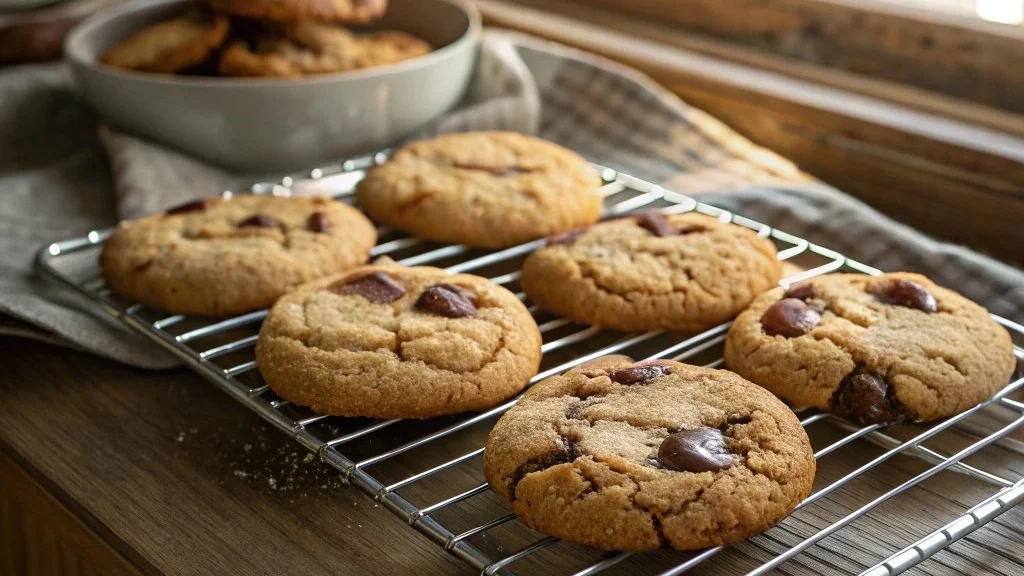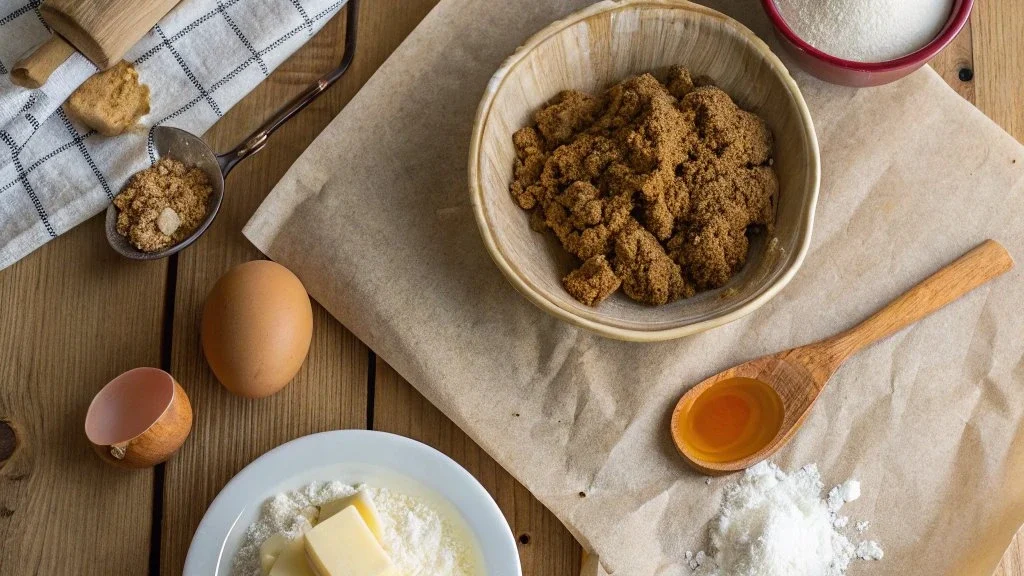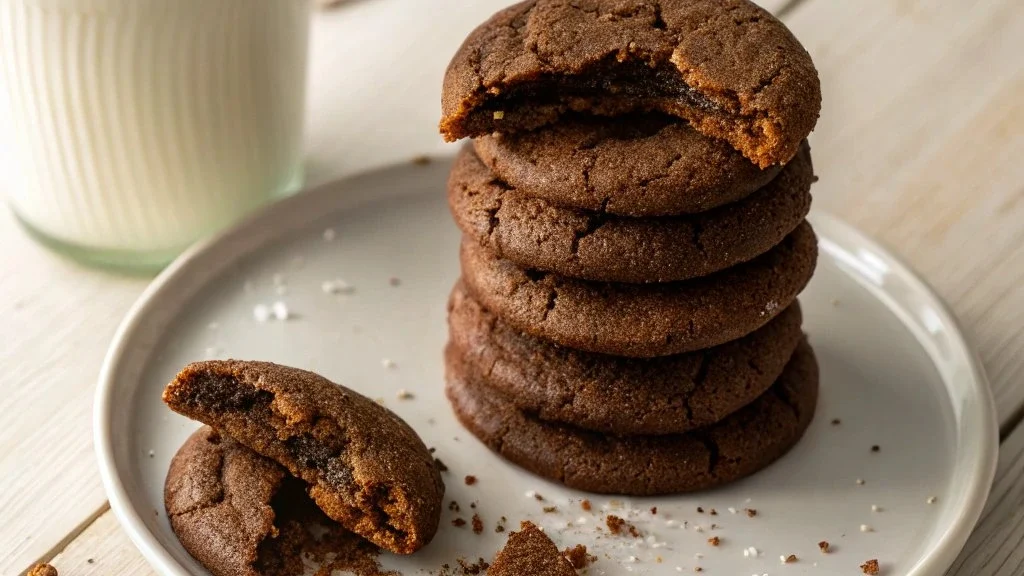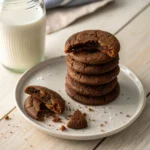Cookies are a timeless treat, and every ingredient in a recipe plays a specific role in achieving the perfect bake. Among these, brown sugar stands out for its unique ability to transform cookies. But what exactly does it do? From creating chewy textures to enhancing flavors and colors, brown sugar is the secret behind many of our favorite cookie recipes. Let’s explore its magic and learn how it can elevate your baking.
Table of Contents

What Is Brown Sugar?
The sweet, slightly caramelized flavor of this sugar variety comes from combining granulated white sugar with molasses. This process gives it its distinct texture, color, and moisture content, making it an essential ingredient in many baking recipes. The molasses not only enhances sweetness but also introduces acidity and extra moisture, both of which significantly affect baked goods, especially cookies.
Unlike refined white sugar, which is dry and crystalline, this variation has a sandy, moist texture due to the molasses coating each granule. This moisture plays a key role in how cookies spread and develop chewiness in the oven.
Types of Brown Sugar: Light vs. Dark
There are two primary types of this sugar, each offering unique characteristics that can influence the flavor, texture, and final outcome of baked goods.
1. Light Brown Sugar
- Molasses Content: About 3.5% molasses, giving it a mild color and taste.
- Flavor Profile: A subtle caramel-like sweetness, making it a great choice for balanced flavors.
- Best Uses: Ideal for chocolate chip cookies, pancakes, muffins, and everyday baking where you want a gentle depth of flavor without overpowering other ingredients.
2. Dark Brown Sugar
- Molasses Content: Approximately 6.5% molasses, nearly double that of the lighter variety.
- Flavor Profile: A richer, more robust taste with deep notes of toffee and caramel.
- Best Uses: Works well in recipes requiring bold flavors, such as gingerbread, spice cookies, barbecue sauces, and molasses-heavy desserts.
How Molasses Affects Baking
The molasses content in this sugar variety introduces several key properties that influence how baked goods turn out:
- Increases Moisture: Helps retain water in doughs and batters, keeping cookies softer and chewier for longer.
- Boosts Leavening: Since molasses is slightly acidic, it reacts with baking soda, creating carbon dioxide bubbles that contribute to lighter, fluffier textures in cookies and cakes.
- Enhances Flavor: The caramelized undertones add richness and complexity, making cookies and other baked goods more deeply satisfying.
Choosing Between Light and Dark Varieties
When deciding which type to use, consider the flavor intensity you want in your final product.
- For a Subtle Sweetness: The lighter option is more delicate, allowing other flavors in the recipe to shine.
- For a Richer Depth: The darker variation is best for recipes needing a bold molasses flavor, such as spiced cookies and sticky glazes.
💡 Pro Tip: If a recipe doesn’t specify which type to use, the lighter version is a safe choice, as its flavor is more neutral and versatile across different recipes.nformed choices to enhance your cookies and other baked goods. Experimenting with both types will reveal how these subtle variations can transform your recipes into something extraordinary!

How Brown Sugar Affects Cookie Texture
One of the standout benefits of brown-sugar in cookie recipes is its ability to create soft, chewy textures that many bakers strive for. This happens because of the unique properties of molasses, which is present in brown-sugar.
Key Reasons for Chewy Cookies with Brown Sugar
- Moisture Retention:
- The molasses in brown sugar is hygroscopic, meaning it attracts and retains water molecules from the surrounding air.
- This additional moisture prevents cookies from drying out and keeps them soft, even after they’ve cooled.
- Over time, cookies made with brown-sugar tend to stay fresher longer than those made with granulated sugar alone.
- Reduced Spreading:
- Brown sugar contains a slight acidity due to the molasses content. When paired with baking soda, this acidity slows down the spread of cookies on the baking sheet.
- The result is thicker cookies with a more pronounced shape, which is particularly desirable for certain types like oatmeal or chocolate chip cookies.
Combining Brown and White Sugar for Perfect Texture
Using a mix of brown sugar and granulated sugar offers the best of both worlds:
- Brown sugar: Contributes moisture, chewiness, and thickness.
- White sugar: Adds crispness and encourages spreading.
By adjusting the ratio of brown to white sugar, you can customize your cookie texture to your preference, whether you like them soft and thick or crispy and thin.
Brown Sugar’s Impact on Flavor
Brown-sugar adds much more than sweetness to cookies—it enriches their flavor, making them more complex and satisfying.
- Caramel Notes:
- The molasses in brown sugar lends a toffee-like, caramelized flavor to cookies.
- This flavor deepens as the cookies bake, creating a rich, golden taste that pairs well with ingredients like chocolate, nuts, or spices.
- Balanced Sweetness:
- Unlike granulated sugar, which is purely sweet, brown-sugar has a slightly tangy and earthy flavor due to the molasses.
- This balances the sweetness of cookies, making them less cloying and more enjoyable to eat.
- Dark vs. Light Brown Sugar:
- Light brown-sugar adds a mild caramel flavor, ideal for versatile recipes like chocolate chip cookies or snickerdoodles.
- Dark brown sugar delivers a bolder, more robust molasses flavor, perfect for recipes that incorporate spices, like gingerbread or molasses cookies.
Recipe: Chewy Brown Sugar Chocolate Chip Cookies
This recipe showcases the best qualities of brown sugar by creating thick, chewy, and flavorful cookies with a soft center and slightly crisp edges.
Ingredients:
- 2 ¼ cups all-purpose flour
- 1 tsp baking soda
- ½ tsp salt
- 1 cup unsalted butter, softened
- 1 ¼ cups packed brown sugar (light or dark)
- ¼ cup granulated sugar
- 2 large eggs
- 2 tsp vanilla extract
- 2 cups semi-sweet chocolate chips
Instructions:
- Preheat the oven to 350°F (175°C) and line baking sheets with parchment paper.
- In a bowl, whisk together the flour, baking soda, and salt. Set aside.
- In a large mixing bowl, cream the butter, brown-sugar, and granulated sugar until light and fluffy.
- Beat in the eggs one at a time, followed by the vanilla extract.
- Gradually add the dry ingredients to the wet ingredients, mixing just until combined.
- Fold in the chocolate chips.
- Scoop the dough into 2-tablespoon portions and place them on the prepared baking sheets, spacing them about 2 inches apart.
- Bake for 10-12 minutes, or until the edges are golden brown but the centers still look slightly underbaked.
- Cool on the baking sheets for 5 minutes before transferring to a wire rack to cool completely.
Pro Tip: For an even richer flavor, chill the dough for at least 30 minutes before baking.
chocolate.
How Brown Sugar Affects Cookie Color
The rich, golden-brown hue of cookies often comes from the inclusion of brown sugar.
- Maillard Reaction: The molasses in brown-sugar contributes to browning during baking, enhancing both flavor and appearance.
- Dark, Caramelized Edges: Cookies with brown-sugar develop a more visually appealing golden crust.
This makes brown-sugar an excellent choice for recipes where color matters, like oatmeal cookies or gingerbread.

Tips for Using Brown Sugar in Cookies
Brown sugar is a versatile and essential ingredient in cookie recipes, but to maximize its benefits, it’s important to use it correctly. Here are some detailed tips to help you make the most of brown sugar when baking cookies:
1. Use Fresh Brown Sugar
Brown sugar tends to harden over time because it loses its natural moisture, making it difficult to mix into recipes. To keep your brown-sugar soft and fresh:
- Store Properly: Place brown-sugar in an airtight container or a resealable plastic bag to prevent it from drying out.
- Use a Moisture Retainer: Add a slice of bread or an apple wedge to the container to help maintain moisture. Replace these items as they dry out.
- Revive Hardened Brown Sugar: If your brown sugar has hardened, soften it by microwaving it for 10–15 seconds with a damp paper towel or using a sugar-softening disk available at baking stores.
Fresh brown sugar ensures that your cookies will retain the desired texture and flavor.
2. Pack It Tightly
When measuring brown sugar, always pack it tightly into the measuring cup. This is because:
- Dense Consistency: Brown sugar is moister and denser than granulated sugar, so packing ensures you measure the correct amount.
- Accurate Measurements: Recipes are designed with packed measurements in mind. Loose scoops of brown sugar may lead to under-measured ingredients, affecting your cookie’s flavor and texture.
Pro Tip: Use a spoon to scoop the brown-sugar into the measuring cup, then press it down firmly with the back of the spoon until it’s compact.
3. Balance with White Sugar
For cookies that have the perfect combination of chewy centers and crisp edges, use a mix of brown sugar and granulated sugar. Here’s why:
- Brown Sugar: Adds moisture and chewiness, while contributing to a rich, caramel-like flavor.
- White Sugar: Promotes spreading, creating crisp edges and a lighter texture.
Suggested Ratio:
- For chewier cookies, use more brown-sugar than white sugar (e.g., 60% brown sugar, 40% white sugar).
- For crispier cookies, increase the amount of white sugar in the mix.
Experimenting with the ratio allows you to customize the texture of your cookies based on your preference.
4. Dark vs. Light Brown Sugar
The type of brown sugar you choose—light or dark—can significantly impact the flavor and appearance of your cookies.
- Light Brown Sugar:
- Contains less molasses (about 3.5%).
- Provides a milder, more subtle caramel flavor.
- Ideal for classic recipes like chocolate chip cookies or sugar cookies where you don’t want the molasses flavor to overpower other ingredients.
- Dark Brown Sugar:
- Contains more molasses (about 6.5%).
- Offers a richer, bolder flavor with deeper caramel and toffee notes.
- Perfect for recipes with spices, chocolate, or nuts, such as gingerbread, molasses cookies, or oatmeal cookies.
Pro Tip: If a recipe doesn’t specify the type of brown-sugar, light brown sugar is generally the safer choice as its milder flavor works well in most cookies.
5. Adjust Liquid Ingredients as Needed
Because brown sugar retains more moisture than granulated sugar, it can slightly alter the overall consistency of your dough. If you’re adding extra brown-sugar to a recipe:
- Reduce other liquid ingredients, such as milk or water, by 1–2 teaspoons to maintain a balanced dough consistency.
- Monitor your dough for stickiness and add a little extra flour if needed.
This ensures that the cookies bake evenly without spreading too much or becoming too soft.
6. Enhance the Flavor with Additional Ingredients
Brown sugar pairs exceptionally well with certain flavors. To enhance its impact in cookies, consider adding:
- Vanilla Extract: Enhances the molasses notes and adds warmth to the flavor.
- Cinnamon or Nutmeg: Complements the caramel and toffee tones in brown-sugar.
- Dark Chocolate Chips: Balances the sweetness of the sugar with a touch of bitterness.
Adding these ingredients can elevate your cookies from simple to gourmet.
Frequently Asked Questions About Brown Sugar in Cookies
1. Can I Substitute White Sugar for Brown Sugar?
Yes, you can substitute white sugar for brown sugar, but the cookies will be less chewy and have a milder flavor. Brown sugar’s molasses is what adds moisture and a rich, caramel-like taste to cookies.
Quick Fix: Mix 1 cup of granulated sugar with 1 tablespoon of molasses to mimic brown-sugar. This simple substitution creates a similar texture and flavor, making it a great option when you’re out of brown-sugar. If your recipe also calls for baking soda, refer to what can I substitute for 1 teaspoon of baking soda? A complete guide for helpful tips.
2. Does Brown Sugar Make Cookies Softer?
Absolutely! Brown sugar’s moisture-retaining properties are one of its standout features. The molasses in brown-sugar attracts and holds water, keeping cookies soft and chewy even after cooling.
This is why brown-sugar is often the star ingredient in soft-baked cookies, such as chocolate chip or oatmeal cookies. For more inspiration, check out these unique cookie recipes to delight your taste buds.
3. What Happens If I Use Dark Brown Sugar Instead of Light?
Using dark brown-sugar instead of light results in cookies with a deeper, more robust flavor and a darker color. Dark brown-sugar contains more molasses than light brown-sugar, intensifying caramel and toffee-like notes.
Ideal Recipes for Dark Brown Sugar:
- Gingerbread cookies
- Molasses cookies
- Spice cookies
Experimenting with this swap can add a delightful twist to your favorite recipes. For example, pairing dark brown-sugar with cornstarch can create soft, chewy cookies. Learn more about what does cornstarch do to cookies to understand its role in baking.
4. How Do I Keep Cookies Made with Brown Sugar Fresh?
Cookies made with brown-sugar stay soft longer due to its moisture content, but proper storage is still crucial. Use an airtight container and add a slice of bread or a damp paper towel to maintain softness.
If your cookies tend to crumble, find useful storage tips in how do you keep crumble cookie good.
5. Can I Use Brown Sugar in Unique Recipes Like Dubai Chocolate Bar Cookies?
Yes! Brown-sugar works wonderfully in recipes with bold flavors like the decadent Dubai chocolate bar recipe. Its rich molasses flavor enhances the complexity of the chocolate while keeping the cookies soft and moist.
Conclusion
More than just a sweetener, this molasses-infused sugar plays a crucial role in baking, transforming ordinary cookies into rich, flavorful treats. Unlike refined white sugar, it contributes moisture, depth, and a soft, chewy texture—qualities that elevate baked goods beyond simple sweetness.
By incorporating this ingredient into your recipes, you can create cookies with a tender bite, caramel-like undertones, and a perfectly balanced texture. Whether you’re baking classic chocolate chip cookies, experimenting with the darker variety for a bolder flavor, or simply looking to enhance the depth of your desserts, this sugar variation is a must-have in every baker’s pantry.
The next time you bake, consider the type of sugar you choose and how it affects the final outcome. With its versatility and ability to enhance both texture and taste, this ingredient is truly a secret weapon for baking success.
Happy baking!

Chewy Brown Sugar Chocolate Chip Cookies
Ingredients
Dry Ingredients
- 2 ¼ cups all-purpose flour
- 1 tsp baking soda
- ½ tsp salt
Wet Ingredients
- 1 cup unsalted butter, softened
- 1 ¼ cups packed brown sugar (light or dark)
- ¼ cup granulated sugar
- 2 large eggs
- 2 tsp vanilla extract
Chocolate Chips
- 2 cups semi-sweet chocolate chips
Instructions
Preparation
- Preheat the oven to 350°F (175°C) and line baking sheets with parchment paper.
- In a bowl, whisk together the flour, baking soda, and salt. Set aside.
- In a large mixing bowl, cream the butter, brown sugar, and granulated sugar until light and fluffy.
- Beat in the eggs one at a time, followed by the vanilla extract.
- Gradually add the dry ingredients to the wet ingredients, mixing just until combined.
- Fold in the chocolate chips.
Baking
- Scoop the dough into 2-tablespoon portions and place them on the prepared baking sheets, spacing them about 2 inches apart.
- Bake for 10-12 minutes, or until the edges are golden brown but the centers still look slightly underbaked.
- Cool on the baking sheets for 5 minutes before transferring to a wire rack to cool completely.





